Last Updated on December 28, 2023 by Amanda P. Brown
Crockery, also referred to as dinnerware or tableware, incorporates a wide range of essential options for our dining experiences. Understanding the various types of crockery available (such as plates, bowls, cups, mugs, serving trays, casserole dishes, etc.) will significantly enhance your table setting. From elegant fine china to durable stoneware, a diverse selection suits every individual’s taste and style.
In addition to the diverse materials and designs, crockery is available in different sizes such as to cater to specific culinary needs and serving requirements. Whether you require elegant teacups for a delicate afternoon tea or generously sized dinner plates for hearty meals, crockery sizes are thoughtfully designed to accommodate different courses and dining preferences, ensuring practicality and visual appeal.
This comprehensive reference strives to enlighten readers on the intriguing world of dinnerware, including the numerous varieties and sizes. Whether you’re looking for delicate saucers for elegant tea parties or adaptable bowls for serving soups and salads, this article will offer helpful advice to help you select the ideal crockery set that enriches your dining experience.
However, to understand the fascinating world of crockery, you need to be aware of the classification of crockery and what are the different types of crockery, and their shapes and styles. Let’s look at the following:
What Are the Different Types of Crockery and Their Sizes
Table of Contents
Classification of Crockery Based on Material
Below are describe the classifications of crockery:
- Porcelain
- Bone China
- Alumina
- Stoneware
- Earthenware
- Terracotta
- Melamine
1. Porcelain
Porcelain originated in ancient China, which is also known as China. It is a durable, precise, nonporous, translucent, and white ceramic ware composed mostly of kaolin (50%), quartz (25%), and feldspar (aluminosilicate mineral) 25%. Additionally, they are made by heating in a kiln between 1,200 and 1,400 °C, where kaolinite clay is often at a higher temperature than other materials.
Furthermore, the translucence, hardness, and strength are due to the formation of glass at such a high temperature and the inclusion of the mineral particles in the extruded body. Otherwise, its smooth texture, lightweight, translucent quality, durability, and spotless white appearance, symbolize refinement and elegance, contributing to an illusion of sophistication within any setting.
In this instance, it has gained wide popularity as a decorative item, dinnerware, and even in making intricate figurines.
2. Bone China
Bone china originates from ‘bone ash,’ which is derived from animal bones (usually cow bones) incorporated into ceramic clay. Furthermore, its formulation has 25% bone ash, 50% calcium phosphate, and 25% china stone, giving it superior physical strength and chip resistance than porcelain or china ceramic.
In addition, its pattern, lightweight, smooth texture, color palette, and design are so diverse that it is appropriate for any event or circumstance. Moreover, due to its high cost, it is out of reach for most diners, and merely a few premium hotels and restaurants are provided.
3. Alumina
Alumina ceramics or aluminum oxide (Al2O3) are superior ceramic materials that are mainly composed of aluminum and oxygen. This alumina ceramic derives from bauxite, which is a white granular or extremely fine, silky, thick powder.
And many industrial plates incorporate this alumina into the clay, which raises the cost of the crockery considerably beyond the regular porcelain. However, it turns out to be far less expensive than bone china, one of the more common alternatives.
Moreover, this alumina-rich crockery comes in a creamy color that prevents abrasion and is perfect for inserts or products requiring wear resistance.
4. Stoneware
Stoneware, or hard pottery, is made from a siliceous paste that is fired at a high temperature to vitrify (make the body glassy). It is even referred to as the forerunner of porcelain due to its production in ancient China.
In comparison with porcelain, stoneware appears to be heavier and more opaque. Additionally, fired stoneware tends to have a grayish appearance, despite the clay base producing a varied range of colors.
However, these plates are available in various colors and designs, so this crockery has become an attractive alternative to various restaurant decors. It is often used as casual and rustic dishes. Moreover, it obtains excellent for daily use.
5. Earthenware
Earthenware is frequently referred to as terracotta, which absorbs liquids like water. Therefore, the materials used in making earthenware include 25% kaolin or clay, 25% ball clay, 35% flint, and 15% china stone which is fired at low temperatures between 1200°C.
Accordingly, it tends to be less hard, easily chipped or cracked, more porous, and less durable than stoneware, which makes it undesirable for microwave and dishwasher use. However, since it is cheap, it can easily be worked to fill these deficiencies and remains suitable for casual dining.
Read More: What is the Difference Between Earthenware and Stoneware?
6. Terracotta
The word terracotta originates from “baked earth,” which is a translation of the Italian language. It appears significantly as terra cotta or terracotta. In contrast, these non-vitreous ceramics, produced from clays that are unglazed or glazed, are fired at low temperatures.
However, its superior versatility and durability are often used in tableware, ovens, and even considered decorative architecture. In particular, it has certain properties that contribute to making it naturally sweet by reacting with acidic foods like tomato sauce.
7. Melamine
Melamine is a type of plastic that is strong, lightweight, and hard thermosetting. And these crockery plates become versatile due to their various design and color features. In China, it is quite popular as a sustainable and ideal healthy option.
These melamine crockery are shatter-resistant and easy to stack for storage, making them an excellent option for outdoor dining or casual settings. Furthermore, it is appropriate for daily use due to its stain and scratch resistance, dishwasher safety, and nearly unbreakability.
Types of Crockery
When it comes to crockery, there are different types of crockery in different sizes and specifications, each based on its unique characteristics and purpose. Let’s look at the following:
1. Bowls

A bowl is a round, deep, oval-shaped, or open-topped container that’s able to keep a substantial amount of food and helps to prepare large batches of food. And the ideal dimensions for these bowls are between 8 and 12 ounces. However, these bowls come in different shapes for specific purposes or culinary preferences, such as salad bowls, pasta bowls, serving bowls, dessert bowls, mixing bowls, etc. The following is a list of some of the crockery bowls, along with their sizes and applications:
Usage: Can be used for preparing, serving, and consuming food.
- Fruit Bowl: With a wide and shallow design and a flat bottom, these bowls hold and display fresh fruits. It varies in shape and typically ranges about 9-13 inches in diameter.
- Cereal Bowl: Deep and round with a wide rim, these bowls are used for breakfast cereals serving and range from 13cm in diameter.
- Finger Bowl: By 14 inches in height and 4 inches in diameter, these bowl is intended only to rinse the fingertips, with sufficient water to cover them.
- Soup Bowl: With a handle or without, a deep and wide soup bowl are perfect for enjoying soups or stews and holds 8–12 ounces on average.
- Coupe Soup Bowl: A saucer-like shape used only for informal dining, about 6 to 9 inches.
- Sugar Bowls: A sugar bowl is a tiny bowl that is primarily used to hold sugar or sugar cubes that are 10.2 centimeters (4 inches) in diameter.
- Mixing bowl: A mixing bowl is a deep, large, and wide bowl that is perfect for mixing ingredients while cooking and baking and comes in diameters ranging from 4 inches to 16 inches or even larger. Additionally, these bowls are also available in sizes 11, 12, 21, 22, 4, 5, 6, 8, and 12 quarts.
- Serving Bowl: For serving salad, fruit, pasta, or other items, a serving bowl is required to be circular, wide, and shallow. Although its diameter varies, it typically ranges between 9 inches (23 cm) and 16 inches (40 cm).
- Soup Bowl: Soup bowls are typically shallower and wider than cereal bowls, which makes them excellent for serving soup, stew, chili, or breakfast cereal. It ranges in diameter from 6 inches (15 cm) to 8 inches (20 cm).
- Pasta Bowl: The pasta bowl is characterized by its wide and shallow design, often with a generous rim that is specifically designed for serving pasta dishes, such as fettuccine, penne, or spaghetti. It has around 8-12 inches in diameter.
- Salad Bowl: With their wide and shallow design and flared rim, salad bowls are ideal for tossing and serving salads. They usually have a diameter of 10-12 inches or even larger.
- Dessert Bowl: These small and shallow bowls serve delectable desserts like ice cream, pudding, or fruit salads. Typically, it has around 4 inches (10 cm) to 6 inches (15 cm) in diameter.
- Rice Bowl: Small to medium-sized for serving individual portions of rice such as fried rice or sushi, and typically small, between 10 to 13 cm in diameter.
Read More: Different Types of Bowl Shapes and Their Uses
2. Plates
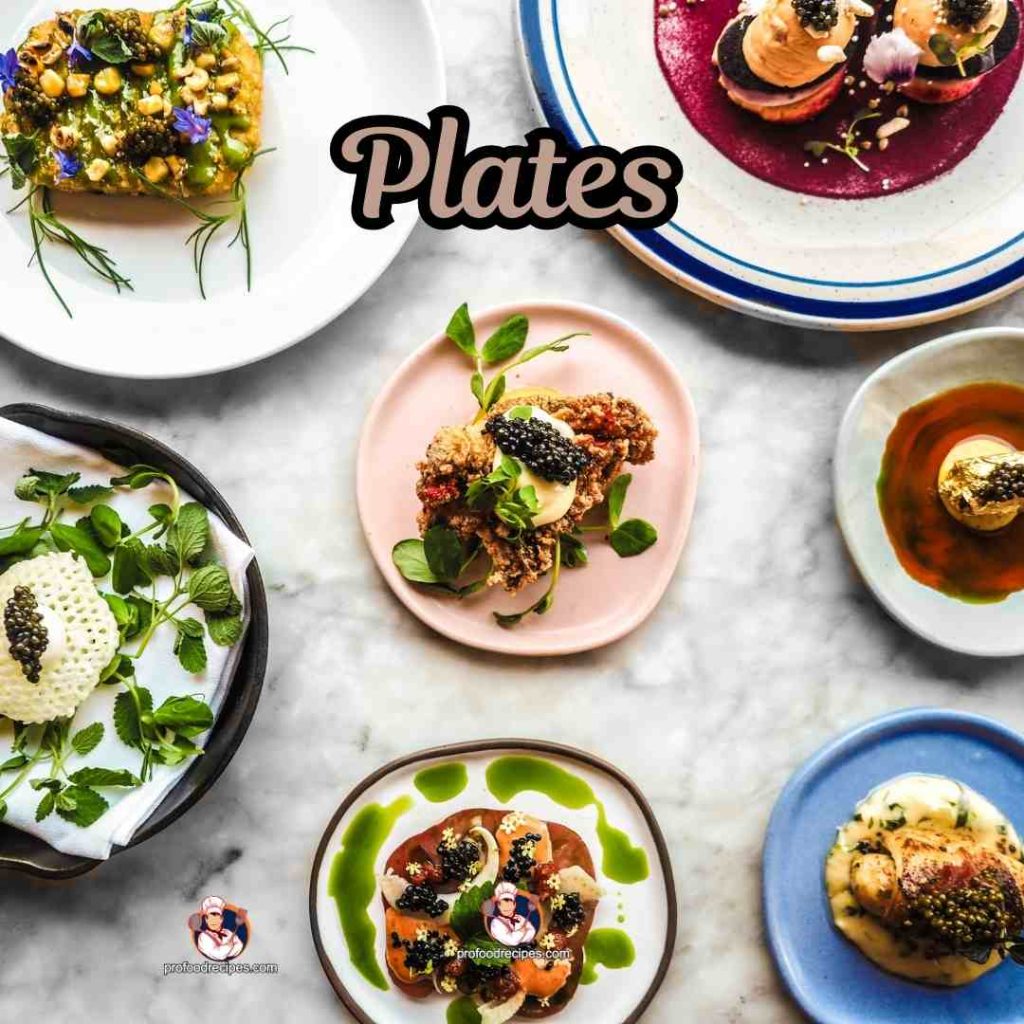
Significantly, a plate is a concave, large, but mostly flat vessel exist that is frequently excellent for serving food. And a standard plate traditionally possesses a diameter of 10.5 inches, but larger plates of 11 or 12 inches have become used in many restaurants in recent years.
In particular, the plates are frequently circular, but they are able to be produced in any waterproof material or many various sizes, such as dinner plates, salad plates, quarter plates, dessert plates, soup plates, etc. Below are the usage and size of different types of plates for serving food:
Usage This plate is versatile for any type of ceremonial or decorative purpose.
- Entrée Plate ( Fish plate/ Half plate/ Dessert plate): Entrée plate is frequently referred to as a fish plate, half plate, or dessert dish. They are essentially used for serving starters, pasta, fish, hors d’oeuvres, main courses, and desserts. Therefore, it’s approximately 8.5 inches (22 cm) in diameter.
- Dessert Plate (also half plate, sweet plate, fruit plate): The dessert plate is widely known as a sweet, half, or fruit plate. These small and decorative plates are particularly appropriate for serving pastries, pies, and cakes as an entrée dish. In terms of its diameter has an 8-inch (20 cm).
- Quarter Plate: B&B plate (bread and butter plate, side plate, under plate): With a small, compact, and round shape, quarter plates are suitable for holding cheese, bread, rolls or as an underliner. And this plate refers to the B&B plate (bread & butter, under plate, side plate). It appears to be around a diameter of 6″ (15cm).
- Cheese Plate: Typically, cheese plates come in round or rectangular shapes with sections, which is an excellent substitute for biscuits, cheese, and after the main course. The diameter of this plate is up to 16 cm.
- Full Plate (Meat plate/ Dinner plate/Joint plate): Full plates, also known as meat, dinner, or joint plates, are appropriate for serving the main dish. And it measures 10″ (25 cm) in size.
- Soup Plate: Deep with a wide rim, soup plates are essential for serving either thin or thick soups and stews. In terms of size, this plate ranges up to 8″ (20 cm).
- Salad Plate: Smaller than dinner plates, salad plates are usually round. They are primarily intended to facilitate the serving of salads, side dishes, and other small amounts of food. It ranges from 7 to 8.5 inches (18 to 22 cm) in diameter.
- Luncheon or Accent plate: A luncheon plate is typically somewhat smaller than a dinner plate which is placed on top of the regular dinner plate to serve salad or dessert. Its diameter is about 9-9.5 inches (23-24 cm).
- Charger Plate: These large and decorative plates are placed underneath the main dinner plate for aesthetic purposes, around 12-14 inches in diameter.
- Pizza Plate: Flat with a wide rim, pizza plates are specially designed for serving pizzas. They commonly range from 12-16 inches in diameter.
- Steak Plate: Oval or rectangular and often featuring a section for sauces, steak plates are used for serving steaks or grilled meats. It has a diameter of about 30.5 cm.
- Appetizer Plate: These small and versatile plates are suitable for serving various appetizers or finger foods and amuse-bouches. They typically measure 5-7 inches in diameter.
- Tapas Plate: Small and either round or square in shape, tapas plates are perfect for serving Spanish tapas or other bite-sized dishes. It ranges from 16cm (6.25″) in diameter.
Read More:
3. Cups and Saucers
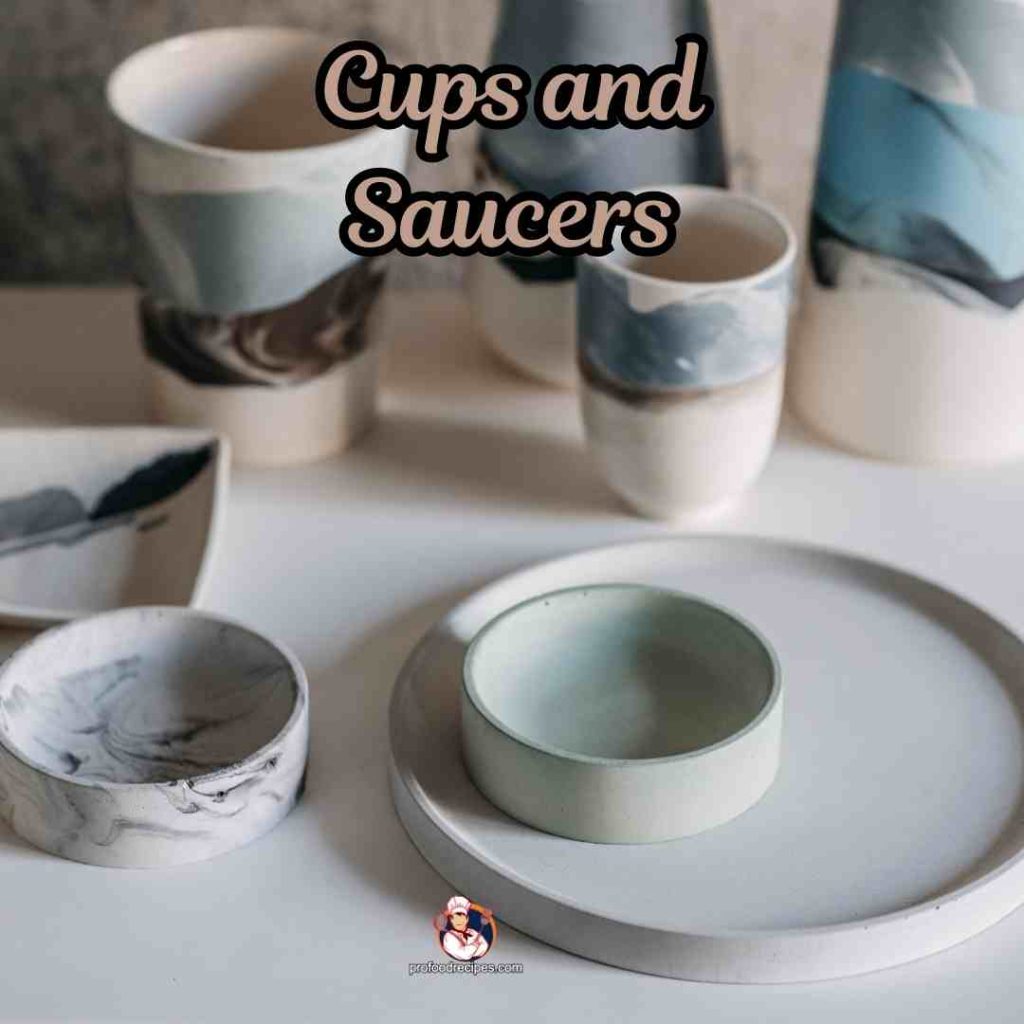
The cup consists of a cylindrical shape that is shorter, taller than wide, handleless, and handles existing pots and saucers, which are a small, rounded dish that sits beneath the cup. Additionally, a cup measures approximately 2 ½ inches tall with 3 inches in diameter, whether accompanying saucers around 6 to 6 12 inches in diameter.
However, for specific purposes, these cups and saucers are seen in different shapes, like tea cups, soup cups, breakfast cups, and saucers. Below are their uses and sizes:
Usage: Cups are often used for beverages such as coffee, tea, or hot chocolate, and saucers are useful for holding spoons or used tea bags.
- Breakfast Cup: During breakfast, these cups are mainly used for serving coffee and tea. The cup measures around 3 ¼ inches high by 4 ½ to 5 ¾ inches in diameter.
- Soup Cup: The soup cup, referred to as the consomme cup, has two handles for serving thin soup and is around the range of 250ml.
- Teacup: A shorter, wider tea cup is typically preferred for serving tea during the day. It ranges from about 200 ml (6^2/3Fl oz).
- Coffee Cup: The coffee cup is a cylindrical base, frequently known as a demitasse, used for serving after-dinner coffee and has 97-100 ml in size.
- Espresso Cup: A small and slender espresso cup, often called demitasse, is typically used to serve espresso shots. It measures around 2.9″ in diameter and 2.25″ in height and holds about 2-3 ounces.
- Cappuccino cup: Cappuccinos typically have a narrow base and a wide rim, perfect for serving cappuccinos, and approximately comes in around 5- to 6 cups.
- Latte Cup: This wide bowl shape is perfect for adding coffee flavor, plant-based milk, or latte art and holds approximately 11 to 15 ounces.
- Demitasse Cup: Small and delicate, these demitasse cups are specifically designed to serve Turkish or strong coffee. They hold around 2 to 3 ounces and are accompanied by a saucer.
4. Mugs
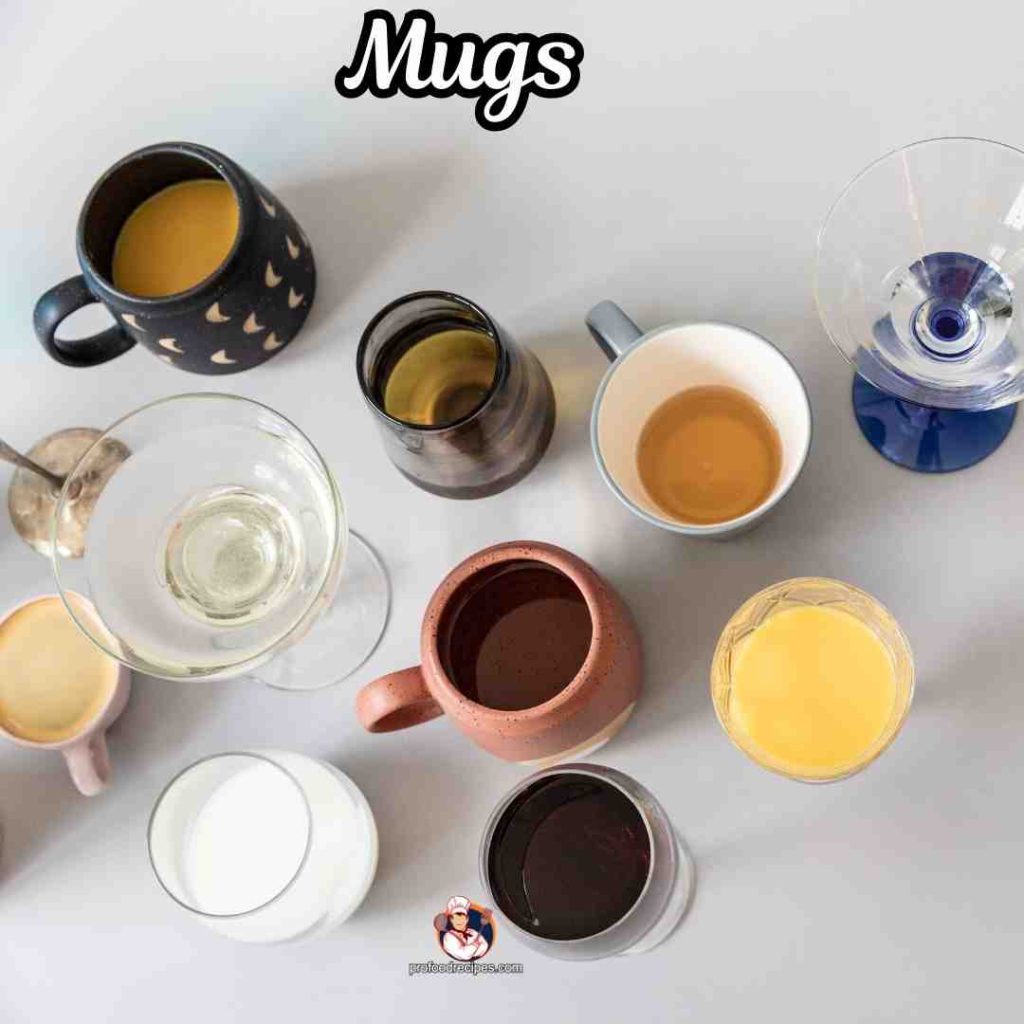
Compared to cups, mugs are larger, have cylindrical cups with a handle, and are capable of holding large quantities of liquid. Additionally, it has a capacity of 240–350 ml (8–12 US fl oz; 8.3–12.5 imp fl oz) of liquid. Even these mugs come in different shapes, like classic mugs, travel mugs, tumblers mugs, vintage coffee mugs, and custom mugs, which are given below.
Usage: They are perfect for serving hot beverages like coffee, hot chocolate, or tea.
- Classic Mug: Classic mugs are often made of ceramic and glass and are used to serve hot drinks (such as hot chocolate, tea, and coffee) in offices, coffee shops, and at home. It holds approximately 8 to 15 oz of coffee.
- Travel Mug: Travel mugs are composed of double-walled stainless steel, which keeps liquids hot or cold for hours. These mugs come in common sizes of 12, 16, and 20 oz, but you’ll find the smallest at 6 oz and the largest at 24 oz.
- Tumblers Mug: Tumbler mugs are made of plastic or metal. Like the Flask Tumbler, it holds hot and cold drinks like iced tea, smoothies, lemonade, and summer cocktails that stay warm for longer. In addition to 16oz, certain of these tumblers come in 20oz, 30oz, and 40oz sizes.
- Vintage Coffee Mugs: Vintage mugs for coffee addicts who need their caffeine dose first thing in the morning. It has dimensions of 9 cm L x 7.2 cm H x 6.4 cm W.
- Custom Mugs: Based on your preferred style, custom coffee mugs contribute to making your logo stand out. It measures 11 X 8 X 10 cm, 380 ml.
Read More: Are Ceramic Mugs Safe To Drink From?
5. Platters

A plate is a large, flat dish that comes in an oval or circular shape, which presents food attractively and decoratively. Moreover, these platters come in different types, such as sandwich platters, Mexican platters, breakfast platters, dessert platters, jacket potato platters, etc. Traditionally, a standard platter has a diameter of 10.5 inches.
Usage: Typically, these platters are excellent for serving main courses, desserts, or appetizers.
6. Serving Trays

A serving tray that comes in a flat, often circular or rectangular shape is used as a container or storage to hold multiple items. And these trays are significantly classified as tableware and serving ware.
Based on the function, they are seen in different types such as plain trays, tea serving trays, metal compartment serving trays, divided trays, etc. However, these serving trays range in size from 12″x15″ to 19″x13″.
Usage: This tray can serve or cook food and carry and store various utensils (such as bowls, spoons, forks, knives, plates, etc.).
7. Casserole Dishes
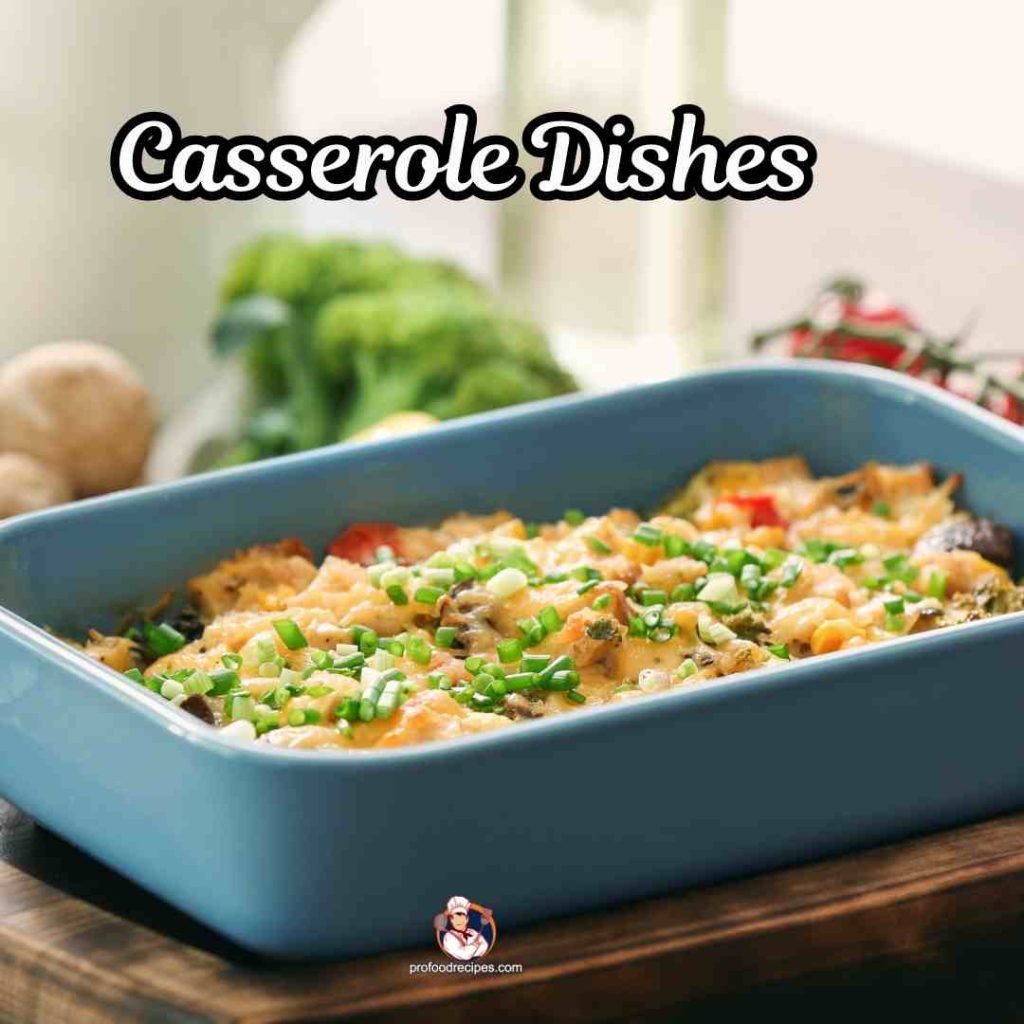
Casserole dishes are versatile baking containers with deep, rectangular, or round shapes. These dishes are suitable for individual portions or larger family-sized servings. There are also sets available with multiple sizes and individual-sized options such as oval, round, covered, individual, etc., and casserole dishes. Therefore, it has around ranges from 9- to 13 inches in diameter and holds approximately 3.7 quarts.
Usage: These dishes are preferred for baking and serving dishessuch aslasagnas, casseroles, and other oven-baked dishes.
8. Ramekins
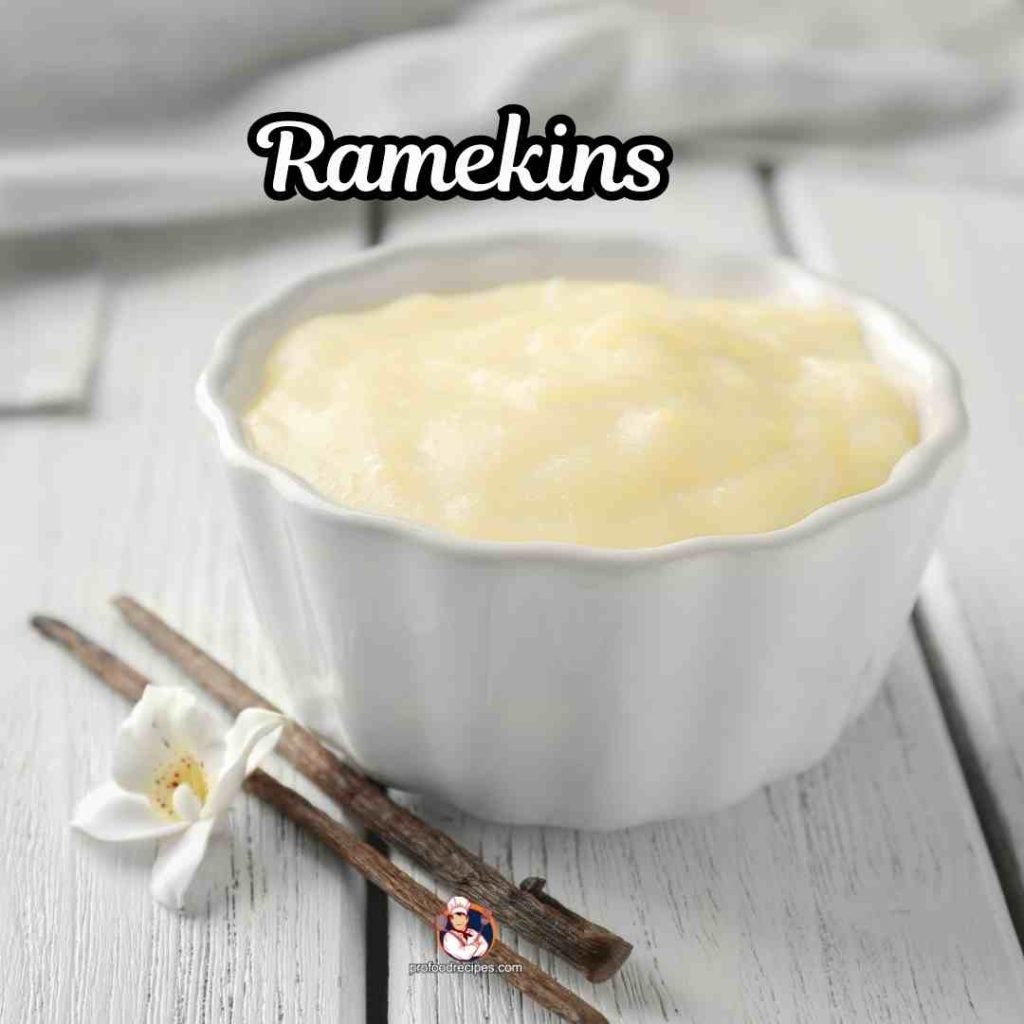
Ramekins, also known as soufflé dishes, are small, solid, round, and have a slight lip and an outside with a fluted texture. And they are available in different shapes to suit different culinary needs and personal preferences, such as oyster cups, cheese pipkins, oyster cups, monkey dishes, or souffle cups. It has around 3″ or 4″ inches in diameter and holds about 2 oz to 6 oz based on size.
Usage: They are frequently used for baking and serving single portions of dishes like soufflés, custards, or crème brûlée.
9. Tea and Coffee Pots
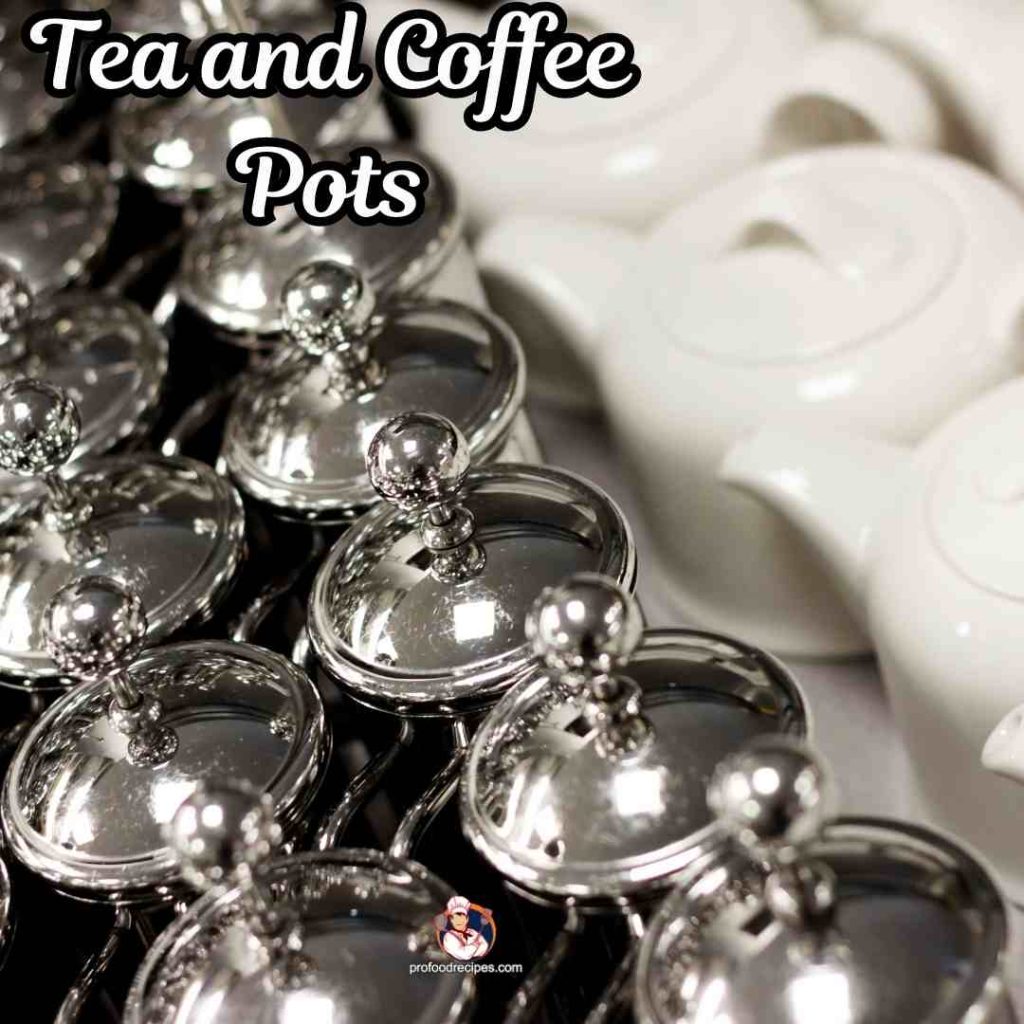
A coffee pot differs from a teapot in terms of shape as coffee pots look tall and narrow, whereas teapots are round. But they are both capable of holding liquid. However, they include a handle for proper handling and a pouring spout. However, there are various types of crockery tea and coffee pots available for serving these adored beverages, as well as French press, electric kettles, tea infuser pots, Turkish coffee pots (Cezve/Ibrik), Ceramic pour-over coffee pots, Japanese-style teapot, etc. Accordingly, they are available in various sizes, offering options from small to large.
Usage: These pots are available for making and serving tea or coffee.
FAQs
What is the Difference Between Crockery and Cutlery?
Crockery is dishes like plates and cups made of ceramics or earthen. Cutlery is knives, forks, spoons, and other tools used for eating and cooking. Crockery is for serving food, while cutlery is for cutting and eating. They’re both important for setting the table and having a meal.
Why is Crockery Called Crockery?
The word crockery started in the 18th century from the old term crocker, meaning a potter. This came from the Old English word croc, which meant a pot or vessel. As time passed, crockery became the name for ceramic dishes like plates and bowls. This shows its historical link to pottery.
What Crockery is Used in Restaurants?
In restaurants, they typically use vitrified crockery. This kind of crockery is heated at high temperatures. Thus, they become tough, resistant to scratches, and durable. It’s perfect for busy restaurants as it can withstand frequent use and is easy to maintain.
Final Verdict
If you are passionate about the art of dining and table settings, this article is for you to explore the fascinating subject of crockery. Each crockery has unique qualities, shapes, and uses, with options such as fine china and durable stoneware. Above, I have mentioned the uses of different types of crockery along with their unique sizes, which help you choose the right crockery for different occasions and needs.
Additionally, if you want to store crockery for a long period, you need to know about proper care and maintenance. However, by reading this article, you can express your creativity and thoughtfulness, which will help inspire other readers to enhance their dining experience.
You May Also Like to Read:
- Is Paper Plate Microwave Safe?
- Are Ceramic Plates Microwave Safe?
- Are Dixie Paper Plates Microwave Safe?
- Are Silicone Plates Microwave Safe?
- Are Clay Plates Microwave Safe?
